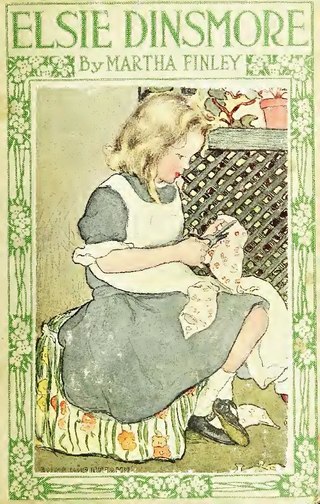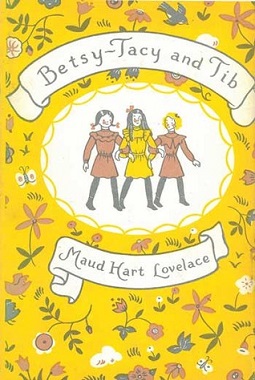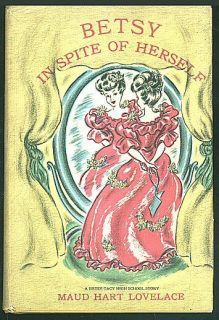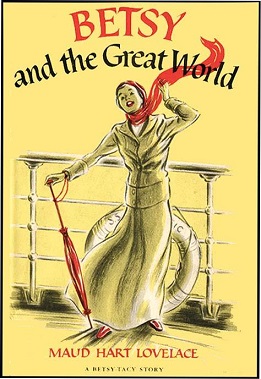Characters and setting
Although the books are fiction, their characters are based closely on Lovelace's own family and friends. Many characters can be matched with individuals, while others are composites drawn from incidents in the lives of several people. [4]
- Betsy Warrington Ray, the protagonist of the series, is based on Maud Palmer Hart (Lovelace). Betsy is sociable, fun-loving and highly imaginative; the early books feature the stories she makes up and tells to her friends. Her ultimately successful quest to become a published author and the challenges she faces in learning to balance her commitment to her writing against other, usually social concerns are themes throughout the series.
- The members of the Ray family are based on the Hart family. [7] Bob Ray, Betsy's father, is based on Thomas Hart, Maud's father; like Thomas Hart, Bob Ray owned a shoe store and made onion sandwiches for family and friends on Sunday evenings. Jule Ray, Betsy's mother, is based on Stella Hart, Maud's mother, who was also red-haired, vivacious, and able to play two songs on the piano, one waltz and one two-step. [3] Betsy's musical, coquettish older sister Julia Ray was based on Maud's older sister Kathleen Hart who, like Julia, studied music in Europe and became an opera singer. Her younger sister Margaret Ray was based on Maud's younger sister, Helen Hart. [8]
- Anastacia "Tacy" Kelly, Betsy's closest friend, is based on Lovelace's lifelong friend Frances "Bick" Kenney. Tacy is shy, sensitive, and fun-loving, from a large Irish family who live across the street from the Rays.
- Thelma "Tib" Muller, the third member of the trio of Betsy, Tacy and Tib, is based on Marjorie "Midge" Gerlach. Tib is fearless and competent; she is also petite, blonde, and learns to be very flirtatious. Tib and her family move back and forth between the Anglo-American atmosphere of Deep Valley and the German-American community of Milwaukee, Wisconsin. She is bilingual and able to navigate the varied social expectations of the contexts through which she moves.
- Joe Willard, Betsy's husband, is based on Maud Hart Lovelace's husband, journalist and novelist Delos Wheeler Lovelace. Maud Hart and Delos Lovelace met in 1917, when she was twenty-five. However, she chose to include a character based on her husband in the books beginning with Heaven to Betsy. She used his descriptions of his boyhood to provide Joe's high school experiences and back story. [4] [7] Joe is an orphan, ambitious, self-sufficient and hard-working. Over the course of the four high school books his relationship with Betsy develops from a friendly rivalry to romance.
- The Crowd, Betsy's large group of friends, are based on Maud Hart Lovelace's own friends. Some characters were one-to-one matches with individuals while others were composites. In some cases, such as Crowd members Carney (Marion Willard) and Cab (Jabez Lloyd), their portrayals were based on lifelong friendships.

The settings reflect extensive research done by Lovelace and, for the first four books, illustrator Lois Lenski, [9] as well as Lovelace's memories. Most of the novels take place in and around the fictional town of Deep Valley, Minnesota, which is based on the author's actual hometown of Mankato, Minnesota. The Ray family and other characters inhabit the houses of their real-life counterparts. Lovelace transformed the neighborhood of 332 and 333 Center Street, her own childhood home and that of Bick Kenney, into the fictional Hill Street, named after the adjoining Big Hill. As Betsy grows older, her horizons expand to include more of the town. Betsy and Tacy Go Downtown introduces the Carnegie Library and downtown Deep Valley with its shops and Opera House. The high school books bring in the surrounding countryside.
Lovelace utilized her own diaries and scrapbooks, contemporary materials such as magazines and catalogs, and correspondence with old friends and other past and present residents of Mankato who provided information to fill out her narratives. [9] "I could make it all up," she wrote, "but in these Betsy-Tacy stories, I love to work from real incidents." [4] Even scenes which are clearly invented share this attention to detail. For example, Betsy in Spite of Herself, in which Betsy visits her friend Tib and her family in Milwaukee, includes a scene where Betsy and the Mullers spend Christmas Eve at the home of Tib's Grosspapa Muller. There was no real-life Grosspapa Muller, Midge Gerlach's paternal grandfather having died before this 1907 visit, and much of the description of Christmas in a wealthy German household was taken from letters written by Kathleen Hart while she was studying in Germany. [10] Another detail, the cast-iron dwarves with which Grosspapa decorated his lawn during the summer, may have come from a then-recent source, novelist Edna Ferber's 1940 memoir A Peculiar Treasure , which states that when Ferber worked as a reporter in Milwaukee during 1906-09, the city's wealthy families decorated their lawns with painted dwarves. [11] [12]

















